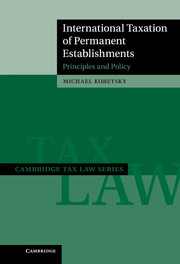Book contents
- Frontmatter
- Contents
- Abbreviations
- 1 Introduction
- 2 International taxation: policy and law
- 3 Some shortcomings of the tax treaty system
- 4 History of tax treaties and the permanent establishment concept
- 5 The role of the OECD Model Tax Treaty and Commentary
- 6 Defining the personality of permanent establishments under former Article 7 and the pre-2008 Commentary and the 2008 Commentary
- 7 Intra-bank loans under the pre-2008 Commentary and 1984 Report
- 8 Intra-bank interest under the 2008 Report
- 9 Business restructuring involving permanent establishments and the OECD transfer pricing methods
- 10 New Article 7 of the OECD Model and Commentary
- 11 Unitary taxation
- 12 Conclusion
- Bibliography
- Index
7 - Intra-bank loans under the pre-2008 Commentary and 1984 Report
Published online by Cambridge University Press: 07 September 2011
- Frontmatter
- Contents
- Abbreviations
- 1 Introduction
- 2 International taxation: policy and law
- 3 Some shortcomings of the tax treaty system
- 4 History of tax treaties and the permanent establishment concept
- 5 The role of the OECD Model Tax Treaty and Commentary
- 6 Defining the personality of permanent establishments under former Article 7 and the pre-2008 Commentary and the 2008 Commentary
- 7 Intra-bank loans under the pre-2008 Commentary and 1984 Report
- 8 Intra-bank interest under the 2008 Report
- 9 Business restructuring involving permanent establishments and the OECD transfer pricing methods
- 10 New Article 7 of the OECD Model and Commentary
- 11 Unitary taxation
- 12 Conclusion
- Bibliography
- Index
Summary
Introduction
Globalization has led to international banks operating through foreign branches, significantly expanding the scope and scale of operations of such banks. Since the 1990s, most developed countries allow international banks to operate through branches rather than requiring them to establish locally incorporated subsidiaries. But it is a challenging task for an international bank to attribute business profits to its branches for tax treaty purposes. A key factor in determining the business profits of a branch of an international bank is the deductibility of interest on intra-bank loans, which are a major source of funds for branches of international banks. Former Article 7 (Article 7 of the 2005 OECD Model and Commentary (pre-2008 Commentary)) and pre-2008 Commentary contain principles on the deductibility of interest on intra-bank loans. In 1984 the OECD published Transfer Pricing and Multinational Enterprise (Three Taxation Issues) (1984 Report) which deals, inter alia, with the allocation of business profits on intra-bank loans to branches of international banks. Together, the views expressed in the pre-2008 Commentary on former Article 7 and the 1984 Report represent the OECD principles on the allocation of business profits on intra-bank loans to branches for most treaties completed before July 2008.
The OECD has recognized the need to revise the international tax principles for determining the business profits of branches of international banks and other permanent establishments under former Article 7. In 2001, the OECD released a Discussion Draft on the Attribution of Profits to Permanent Establishments (2001 Discussion Draft) containing proposals for attributing profits to a permanent establishment under former Article 7 of the OECD Model. The objective of the proposals was to establish a consensus interpretation of former Article 7. The 2001 Discussion Draft contained two parts, Part I setting out the proposed measures and Part II applying them to branches of international banks. In 2003 the OECD released a revised Part II of the Discussion Draft (2003 Discussion Draft). The proposals in Part II of the 2003 Discussion Draft were designed to replace the 1984 Report. A feature of the proposals is to treat a branch of an international bank as a distinct and separate bank. In 2008, the OECD published the 2008 Report and the 2008 OECD Model with a revised Commentary on former Article 7 (2008 Commentary). The 2008 Commentary incorporated part of the 2008 Report. Part II of the 2008 Report (Special Considerations for Applying the Authorized OECD Approach to Permanent Establishments of Banks) replaces the 1984 Report and was incorporated in the 2008 Commentary. But the 1984 Report may be used for the numerous tax treaties which were concluded before 22 July 2008. Although some countries may seek to apply the 2008 Commentary to treaties concluded before 22 July 2008, other countries may not take that approach, as the changes to the 2008 Commentary were significant and it would be inappropriate to apply these changes to treaties concluded before 22 July 2008. As some tax treaties concluded before 22 July 2008 were negotiated in anticipation of the 2008 Report, it may be appropriate to use Part II of the 2008 Report in applying former Article 7 and the 2008 Commentary to branches of international banks.
- Type
- Chapter
- Information
- International Taxation of Permanent EstablishmentsPrinciples and Policy, pp. 238 - 275Publisher: Cambridge University PressPrint publication year: 2011



